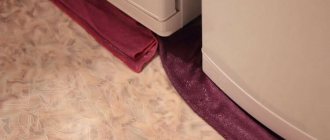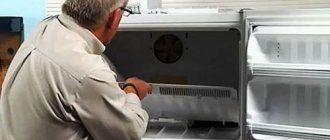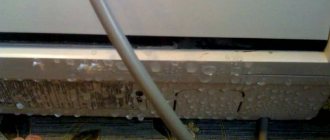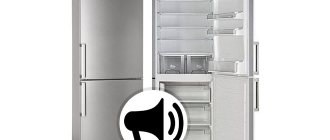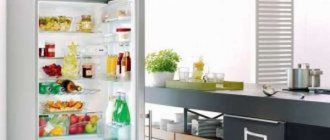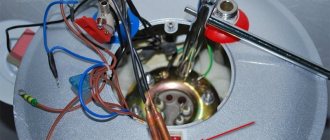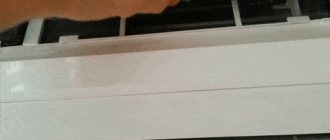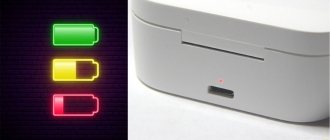Reasons for the appearance of puddles under the refrigerator
What to do if your refrigerator is leaking? Some people choose to ignore the problem and wipe the moisture away with a rag from time to time, but this will only make the situation worse.
If there are signs of leakage from the device, the first step is to inspect it. It is important to determine where the moisture is coming from - inside or outside, this will help determine its cause.
Reasons for water appearing under the refrigerator:
- blockage in the drainage hole;
- shift of the drainage tube;
- loose fit of the freezer door;
- violation of the integrity of the water collection tray;
- evaporator heater failure;
- thermostat malfunction;
- wear of the rubber seal on the doors;
- incorrect installation of equipment.
When checking the machine, it is important to pay attention to the fruit and vegetable drawers, as well as the walls. They must be dry, free of ice and frost. It is also a good idea to inspect the water collection tray - sometimes the cause of the “flood” lies in its damage.
Important! Water causes equipment parts to rust, which can lead to breakdowns.
Inefficient compressor operation
Description. The refrigerator completely stops working. An impressive puddle forms under it.
We suggest you familiarize yourself with mold under the wallpaper, how to get rid of mold remedies
Solution. This problem is classified as serious. It occurs quite often, and its elimination requires a lot of time and effort. In addition, to eliminate such a problem, significant financial expenditures will be required. Repairs are not possible here. The damaged mechanism needs to be replaced. Experts do not recommend doing this on your own. So, among other things, you will need to hire a specialist.
One of the reasons why a refrigerator leaks may be a compressor that has served its useful life and has already lost its former efficiency. This is a device that creates pressure inside the system and circulates the refrigerant in a vicious circle. This refrigerant contracts in one area and absorbs heat and expands in another, which helps release heat.
Ice in the freezer may melt more rapidly over time, which may not be noticeable immediately. This will lead to intense accumulation of condensate in the evaporator, and it may even overflow. As a result, the refrigerator will leak. The reason for this will be precisely the inefficient operation of the compressor. Without special knowledge, you will not be able to repair the compressor yourself.
If there is an oil leak, when the integrity of the compressor is compromised, liquid accumulates under the refrigerator. When you find an oil puddle, the first thing to do is pay attention to the color of the liquid. It is important that the shade is light. A dark color or the formation of acidity indicates a malfunction of the unit.
| It is not recommended to try to fix an oil leak yourself without certain knowledge. It is better to use the services of a refrigerator repair specialist. During the repair process, the first step is to seal the connecting hoses in order to obtain a single system. Next, the valves on the motor-compressor are tightened and the oil is pumped out. The resulting liquid is diagnosed for color and quantity to determine associated faults. Then new oil is pumped in. |
If the refrigerator is leaking from below
Puddles on the floor under the refrigerator are not just a nuisance, but a signal indicating a malfunction. There are several reasons why water does not pour into a special hole, but straight onto the floor.
Blockage in freezer drain hole
The accumulation of small debris leads to blockage of the drainage hole intended for removing water. Small crumbs or ice clog the system, interfering with the removal of fluid. Excess water freezes and forms ice or a snow coat. The liquid that has not had time to harden flows through the rubber seal onto the floor.
You can solve this problem by cleaning the drainage drain. It is difficult to do this yourself, since the drain is located inside the equipment. It is better to entrust the cleaning to a specialist.
The freezer doesn't close tightly
If the tightness of the rubber seals is broken, warm air penetrates into the freezer . The system begins to freeze more intensely - the food gets frozen, water accumulates under the trays, and puddles are visible under the unit.
Working in intensive mode leads to the appearance of ice. Every time you open the refrigerator, heat enters it, which melts the ice “coat”. As a result, the drainage drain and water tray cannot cope with the large volume of liquid. Replacing the seal will solve the problem.
Shifting the drain pipe
When rearranging the equipment, the tube leading the liquid into the tray may have come off, so the water flows directly onto the floor. How to determine that the reason for the appearance of water is the shift of the tube? In appearance, it seems that the unit is working without problems - there is no moisture, ice or snow coat inside, but water accumulates under the unit.
Move the refrigerator aside and check where the tube comes out. You can set it in place yourself; no tools are needed.
Failure of the water collection tank
When moving or rearranging the unit, the water collection tray often breaks or cracks. You can check the integrity of the tank yourself - just move the refrigerator away. However, replacing the container should be done by a specialist - he will select the volume and size suitable for a particular model.
The refrigerator is leaking from inside
Owners of a No Frost refrigerator often ask why water flows from the top of the freezer. There can also be several reasons and they do not always require expensive repairs.
The appearance of water inside the refrigerator leads to the formation of corrosion centers through which freon will evaporate. Removing rust, sealing equipment and refilling it with freon will result in serious expenses. Therefore, it is so important to determine the cause of the fluid flow in time.
Clogged drain hole in the refrigerator compartment
If water flows down the wall inside the refrigerator, this is a sign of a blockage in the drainage hole . Liquid also accumulates under the trays.
Cleaning the drain will help solve the problem. It is located inside the refrigerator at the bottom of the back wall. To clean, use a small syringe with warm water or baking soda solution. You need to inject the liquid into the tube with strong pressure. If after this the situation has not changed, try to push the stopper with a cotton swab, cocktail tube or wire - the main thing is not to drop these objects inside the tube.
Important! Before cleaning the drain hole, it is recommended to completely defrost the refrigerator to remove any icing.
Faulty thermostat
The thermostat is responsible for the timely activation and activation of the motor-compressor. If it breaks down, the no frost indicator light may continue to light, however, the compressor stops working. The ice begins to melt, filling the refrigerator with water.
In modern models, the role of a thermostat is performed by temperature sensors. There can be up to five of them in one refrigerator - it all depends on the model. You will not be able to change a non-working part yourself.
Signs of a broken temperature sensor:
- an increase in temperature in one or both chambers of the refrigerator;
- turning on the Alarm indicator;
- change in compressor operation - the motor rarely turns off or runs without interruption;
- the formation of a thick layer of ice on the rear inner wall;
- freezing of products.
Before calling a technician, empty the refrigerator of food and remove all moisture.
Refrigerator sealing problems
Often, after moving or installing a new refrigerator, problems with sealing may occur. If the refrigerator is not level, the door is skewed and does not fit tightly. As a result, heat penetrates into the compartment, and the equipment tries to equalize the mode by freezing the food. The drainage system cannot cope with the load; liquid leaks both inside and under the equipment. The problem can be easily solved - level the refrigerator.
A similar situation arises if the rubber seals are leaky.
Evaporator heater failure
If a layer of snow or ice has formed inside the freezers of no frost models, this is a sign of a breakdown of the evaporator heater. When the freezer compartment is opened, heat enters it, defrosting the snow; the drainage system cannot cope with the increased volume of liquid. The water tray overflows and begins to leak. The problem is solved by replacing the faulty part.
Leak from below
The appearance of drops of moisture on the inside rear wall of the refrigerator is absolutely normal. This is the physical process of condensation of water vapor on a cold surface. However, if there is so much condensate that it flows off in a trickle, this is a signal of improper operation of the device.
The temperature in the room may be very high. This forces the compressor to run for a longer time. The thermostat is set too low.
Loading hot food into the chamber and frequently opening doors also causes increased moisture release.
Some Liebherr models have a BioFresh zone. It is separated by a vertical partition and neither ice nor moisture ever appears in it.
So, if a refrigerator breaks down and water accumulates under it, then you need to go through the entire chain of condensate drainage and evaporation. There's bound to be a problem somewhere. Note that this is an insignificant problem that can be solved independently. In this case, you most often do not need to call a technician, since there is no technical breakdown here.
If you don’t understand why the refrigerator is leaking from below, then let us remind you once again that the drained condensate accumulates on the evaporator - a plastic container that is heated by the compressor. A leak from below indicates that this container is overfilled, broken, or crooked. In this case, water can only flow from below, and the inside of the chambers will be dry.
In order to understand exactly why the refrigerator is leaking from below, you need to unfold it and inspect the compressor. It is usually located at the back of the household appliance and is located at the bottom. An open container can be adjacent to it, installed either on top or end-to-end (it all depends on the model). Many containers (evaporators) are simply glued to the compressor, and when the glue comes off, the evaporators themselves come off, causing water from the drainage hole to simply drip onto the floor. This is where the leak occurs. Also, the evaporator may simply crack, and through the crack water will flow onto the floor.
In some cases, water appears under the refrigerator due to the fact that the condensate flowing into the evaporator simply does not have time to evaporate. This is possible if the refrigerator is forgotten to be closed or opened too often. This leads to a large amount of moisture entering the chamber, which then condenses in large volumes.
In this case, it is enough to simply remove the evaporator (if it is removable) and empty it. If it is tightly glued, you can use a syringe to pump out all the water from it. By the way, an overfilled condensate container may indicate low heating of the compressor. In turn, this indicates a loss of efficiency of its work. However, in this case, you will definitely notice that the device has become weakly cold; the presence of water on the floor will be the last thing that interests you.
In any case, the condensate container (evaporator) is the main reason why water flows from under the refrigerator. There can be no other options. Another thing is when the refrigerator leaks inside.
As you already know, condensation accumulates on the back wall of the chamber and then flows through the drainage hole into the evaporator. This hole may simply become clogged, and then water will not be able to pass through it. Consequently, the container itself for collecting condensate will be empty, and there will simply be nothing to evaporate from there.
We suggest you familiarize yourself with How many degrees to set in the refrigerator
If this hole becomes clogged (a parsley leaf can get there, for example), then water will flow into the chamber itself. As a result, there will be a puddle at the very bottom of the refrigerator compartment, which over time will become so large that it will simply overflow.
What to do in this case? First of all, you need to find a drainage hole - look for it on the back wall (all food must first be removed). Found it? Look visually to see if anything is preventing the free flow of water to it? If there is any obstacle, it must be removed.
If everything is clean, then there is a possibility of internal blockage. This means that the entire tube must be cleaned. This can be done using water pressure. You can simply pour water from the kettle into it and see if it flows out into the condensate container at the back. Such a flow can move a blockage that the condensate could not move. Still, it flows into the pan in small drops, and not with a powerful pressure.
If you cannot break through the blockage using a stream of water, you can try to remove it using a long wire. Most often this helps solve this problem.
A refrigerator is an essential appliance; replacement or repair cannot wait, and the cost can seriously undermine the family budget. The appearance of water in it is the first sign that something is wrong with the device.
To avoid unplanned expenses, you need to use the device correctly:
- regularly clean the inside of the refrigerator;
- place products at a distance of 2-5 cm from the walls;
- defrost when a fur coat appears; refrigerators with dry freezing are also defrosted at least once a year;
- do not place hot foods inside;
- close the door tightly.
If, nevertheless, the refrigerator begins to leak, you do not need to turn a blind eye to it. Even a minor malfunction, such as a loose door, leads to increased stress on the main parts and accelerates the breakdown of the refrigerator.
A specialist must be called in the following situations:
- leaks in refrigerators with a dry freezing system;
- clogged hole in the freezer;
- breakdown of the thermostat, compressor;
- need to change the pallet.
Water accumulating in or under the refrigerator should not be alarming. In most cases, the problem is solved very simply and is associated with violations of the rules of use. If the device leaks very often, despite regular cleaning, you should definitely contact a specialist.
If, in addition to the water collected outside, drops of water were found on the walls inside, there may be five reasons for the leak:
- The door is constantly not tightly closed or slightly open. When the refrigerator loses cold, it works with increased power, trying to maintain the temperature regime. Water condenses on the walls, forming a crust that can melt and accumulate below, overflowing the drainage. In this case, the door hinges may need to be adjusted. In addition, the door may come off because the refrigerator is not level.
- When the problem is not in the door itself, but the tightness is broken, the seal has become unusable. This part is an elastic band on the door, a kind of layer between it and the body of the refrigerator. If it does not cope with its function, then it is either worn out or deformed due to careless handling. In any case, the seal needs to be replaced. You should contact a specialist to select and install it correctly and firmly. This problem also applies to refrigerators of the “No frost” system.
- When water accumulates under the vegetable drawers, the refrigerator drain hole is most likely clogged. Pieces of food or ice could have gotten in there. The food debris will begin to rot, giving the water a brown color and corresponding odor. To avoid this, it is recommended to periodically wipe the evaporator.
The problem is solved by cleaning the drain. The refrigerator is first turned off and defrosted. You can try to clear the hole by blowing from a straw. Another way is to rinse with warm water (or soda solution) using a syringe with the needle removed or a syringe. In any case, you need to create a fairly strong pressure.
- When the drain drain in the freezer compartment is clogged, water and ice accumulate mainly near the door. To clean it, you need to remove the inner back wall of the refrigerator, since otherwise you won’t be able to get to the hole. It is better not to take risks by following the instructions, but to call a specialist.
- You cannot repair a broken thermostat yourself; it is recommended to contact a specialist. Thermal sensor is a mechanism that regulates temperature and sends signals to the compressor. If the regulation does not work properly, you will need to replace the broken part.
When the liquid is only on the floor, the problem should be looked for in other ways. Experienced craftsmen identify the following reasons why a refrigerator leaks:
- failure of the drainage tube;
- evaporator failure;
- problems with the tank.
This reason is one of the most common causes of refrigerator leaks. Unlike the previously discussed breakdowns, failure of the drainage tube causes only external leakage. Thus, water flows from under the refrigerator, but the chamber itself is dry.
If there is a small leak, but the refrigerator is freezing, this will not affect the food. However, you should not delay troubleshooting and eliminating it. Constant exposure to moisture on the working parts of a household appliance can cause larger breakdowns.
If you are unable to fix the equipment breakdown yourself, the technicians advise you to contact a service center.
In this case, there are several operating rules that will help avoid breakdowns:
- Do not leave the door open. Some people leave the refrigerator open to eliminate the unpleasant odor that appears in the refrigerator compartment. If such an action is performed once, it will not cause much harm to the device. However, frequent ventilation or loose closing of the door causes ice to form on the walls and failure of the main components of the device.
- To prevent clogging of the drain hole located in the refrigerator compartment, you need to be careful when placing food on the shelves. Products should not be placed close to the back wall. Otherwise, pieces of food may get into the drain hole and cause a blockage.
- It is not recommended to place liquids in containers without lids into the chamber. Thus, pots of soup, open bottles of juice or milk contribute to the evaporation of liquid and its settling on the walls of the chamber in the form of frost and ice.
- When defrosting, some try to speed up the process, so they scrape off pieces of ice with a knife or other sharp objects. Doing this is strictly not recommended, because... You can damage the parts of the refrigerator and it will soon leak.
- Dust that accumulates on the back of a household appliance can cause failure of the main parts, so you need to regularly remove dirt.
We suggest you read: How to clean a blood stain from a mattress
